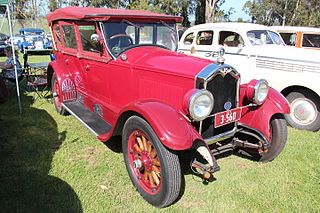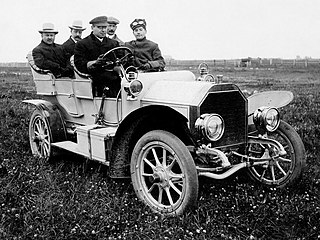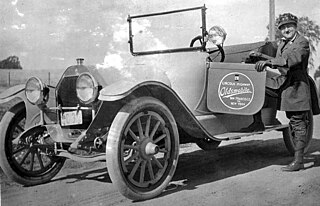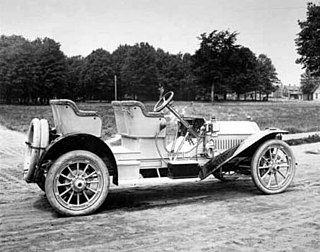
The Oldsmobile Firenza was a compact car which was produced by Oldsmobile from 1982 to 1988. It was based on the front-wheel drive GM J platform, which was shared with the Buick Skyhawk, Cadillac Cimarron, Chevrolet Cavalier and Pontiac Sunbird. It was not based on the European market Vauxhall Firenza, but on the same platform as the Vauxhall Cavalier Mk 2 / Opel Ascona C. The Firenza name was previously used as a performance package on the previous generation Oldsmobile Starfire hatchback.

The Oldsmobile Series 70 is a full-size midrange automobile produced by Oldsmobile between the 1939 and 1950 model years. Oldsmobiles of this time period were in an unusual "middle" position in GM's hierarchy of automobile brands. Chevrolet and Pontiac were the budget priced models, while Buick and Cadillac were the luxury brands. GM would share their "A" body platforms between Chevrolet, Pontiac, and "B" body on Oldsmobile and Buick, while leaving Cadillac on the senior "C" platform. Oldsmobiles were then branded as "luxury level" Chevrolets and Pontiacs, while Oldsmobiles using the "B" platform were "budget priced" Buicks and Cadillacs.

Viking was a brand of automobiles manufactured by General Motors as a supplement to Oldsmobile division for model years 1929 to 1931 and used the GM B platform. It was shared with the Oakland Model 301 for 1930 and 1931.

The Buick Standard Six Series 20 was manufactured by Buick at what would later become known as the Buick City factory on Hamilton Ave. in Flint, Michigan, and was the junior model to the Buick Master Six between 1925 through 1929, and shared the GM A platform with Oldsmobile, Oakland and Chevrolet. The Standard Six evolved from the earlier Buick Six when the Buick 4-cylinder was cancelled. The Standard Six was the most popular Buick sold while being more upscale to the Oldsmobile Six. It was the senior brand to Marquette under the General Motors Companion Make Program until Marquette was cancelled one year later. It replaced the earlier Buick Six that was introduced in 1916, and was replaced with the Buick Series 50. Coachwork continued to be offered by Fisher Body who was the primary supplier of all GM products at this time, and Duco automotive lacquer paint, introduced by DuPont was the first quick drying multi-color line of nitrocellulose lacquers made especially for the automotive industry.

The Chevrolet Superior Series F was manufactured by Chevrolet from 1923 to 1926, with a different series per year. The 1923 model was known as the Series B, the 1924 model was the Series F, for 1925 it was known as the Series K and the 1926 Superior was known as the Series V. It was replaced in 1927 by the Series AA Capitol. It was the first Chevrolet that didn't have a larger companion model and was the only car sold by Chevrolet in several body style configurations all supplied by Fisher Body. Each year new mechanical changes, appearance updates or optional features that became standard in subsequent years became expected of all GM products including Chevrolet. Body styles were separated into open and closed which meant closed included retractable glass in the doors and glass surrounding rear seat passengers. Standard items included tools, a jack for tire removal, speedometer, outside lockable door handles, ammeter, oil pressure gauge, dashboard light, choke pull knob, electric horn, ignition theft lock, and a two piece vertical ventilating windshield that allowed fresh air to enter the passenger compartment. Wheels were 30" and came standard with hickory wood spokes or optional pressed steel discs. For 1925, bumpers were offered optionally along with outside side view mirrors, heater for passenger compartment and a clock.

The Buick 4 was a series of passenger cars produced by the Buick Division of GM from 1909 through 1918, and was available as a touring car, phaeton or roadster. It was available with the Buick Model B as a larger alternative offering a larger engine and better durability. It became the junior sedan in 1914 when the Buick Six was introduced.

The Oldsmobile Model 30, which continued to be known as the Oldsmobile Six, was built from the 1923 through 1927. Each year it was built, it was given the suffix 30-A, 30-B, 30-C, 30-D and 30-E for the last year of production, all having been manufactured in Lansing, Michigan. General Motors used the GM A platform, shared with the Buick Standard Six and the Oakland Six, and the yearly changes were the result of a new business philosophy called planned obsolescence. The Model 30 was Oldsmobile mid-level product and introduced the flathead Oldsmobile straight-6 engine, while the Oldsmobile Model 43 with a four-cylinder engine remained the entry level product. When the top level Oldsmobile Light Eight, with the flathead Oldsmobile V8 engine was cancelled in 1923, the Oldsmobile Six became the top level vehicle. It replaced the Oldsmobile Model 37 introduced in 1917, and was replaced by the Oldsmobile F-Series introduced in 1928. In 5 years, 236,474 cars were built. The growing popularity of GM's brands, like Oldsmobile, contributed to becoming the largest automobile manufacturer when sales overtook the Ford Motor Company during this time period. Coachwork for the various bodystyles were supplied by Fisher Body of Detroit, MI, and starting with the 1923 model year, all GM products adopted a shared appearance, with brand specific unique appearance features. The retail price had dropped considerably from previous years due to the popularity and affordability of the Ford Model T, with the top level sedan at US$1,095.

The Model S was the first four-seat passenger car produced by Oldsmobile in 1906, offered as a larger alternative to the Model R Curved Dash runabout that appeared in 1901. The advertised price was $2,250. It was Oldsmobile's first four cylinder car and took the top level marketing position above the Model L and the entry-level Model R. It was one of the last independently developed products before they joined General Motors in 1908, and competed against Buick, Ford and other automakers at the time. It was built at the Oldsmobile factory in Detroit and developed by Frederick and Angus Smith, whose father Samuel L. Smith was the primary investor, and R. E. Olds had left the company due to an argument with Oldsmobile Board of Directors.
The Model 42 was an entry-level four seat passenger car produced by GM's Oldsmobile Division in 1914. It was offered as a replacement to the Oldsmobile Curved Dash runabout when it was discontinued in 1908, and was the junior platform to the Oldsmobile Six introduced in 1913. GM had acquired Elmore Manufacturing Company, Oldsmobile and Oakland Motor Car Company in 1908 and Cartercar and Rainier Motor Car Company in 1909 as their entry-level models, and Oldsmobile products were being repositioned in their new hierarchy as GM began to consolidate operations after William Durant had left.

The Model 43 was an entry-level four seat passenger car produced by GM's Oldsmobile Division in 1915 and 1916, then again in 1921 and 1922. It replaced the Model 42 also known as the "Baby Olds", while the most significant improvement was a longer wheelbase shared with the Buick Series C. Until GM assumed control of Chevrolet in 1917, the previous Model 42 and the Model 43 were GM's entry-level cars which led to the interrupted production of the Model 43 as Oldsmobile was promoted as a higher content product. It was also known as the "Oldsmobile Four" and competed with the Chevrolet Series H as an entry-level model until GM bought Chevrolet. It was the junior level product to the upscale Oldsmobile Light Eight. It was Oldsmobile's last four-cylinder car until 1977 with the Oldsmobile Starfire.

The Model M was a four-seat passenger car produced by Oldsmobile in 1908, offered as a mid-range alternative to the Model R Curved Dash runabout that appeared in 1901, replacing the Model A. It was the junior sedan to the first six-cylinder sedan called the Oldsmobile Model Z also introduced in 1908, but was larger than the Oldsmobile Model X.

The Model D was a four-seat passenger car produced by General Motors under the Oldsmobile brand in 1909, replacing the Model M. It was the last car engineered by Oldsmobile before it became a division of GM and began sharing a platform with Buick.
The Oldsmobile Series 28, also known as the Autocrat, was a mid-level four seat passenger car produced by GM's Oldsmobile Division for 1911 and 1912. It was based on the top-level Oldsmobile Limited while using a four-cylinder engine, and was manufactured in Lansing, Michigan.

The Oldsmobile F-Series was a pre-WWII passenger car built from the 1928 through 1938 model years. The first generation continued the tradition of adding a series number for each model year; F-28, F-29, F-30 and F-31. The second generation, signified by a completely new bodystyle appearance was built from 1932 through 1938, all having been manufactured in Lansing, Michigan. 1926 saw the introduction of GM's most recognized business model, the use of common platforms shared amongst the brands, and Oldsmobile and Buick shared the GM B platform. The F-Series was shared with the Buick Master Six and was also known as the Oldsmobile Six which was introduced as a name earlier in 1913.

The Oldsmobile L-Series, or the Oldsmobile 8, was built from the 1932 through 1938. Oldsmobile hadn't offered a full-sized luxury flagship since the cancellation of the Oldsmobile Light Eight in 1923, and the Viking upscale companion brand to Oldsmobile didn't sell very well, being cancelled after two years. The 1933 model introduced a completely new body style influenced by the "streamlined" appearance, and it was shared with all GM brands due to GM's Art and Color Studio headed by Harley Earl. The appearance showed influences of Chrysler and Lincoln-Zephyr vehicles, and all Oldsmobiles were manufactured in Lansing, Michigan. Due to the popularity of the Oldsmobile F-Series, Oldsmobile recognized an opportunity to sell a similar sized alternative to the Buick Super, the Cadillac Series 355, and the "junior" companion brand LaSalle a platform the L-Series shared on the GM C platform. It was replaced by the Oldsmobile Series 90 introduced in 1938, and it was exported to Japan as a knock down kit and assembled at Osaka Assembly in Osaka, Japan.

The Oldsmobile Light Eight was an automobile produced by the Oldsmobile Division of General Motors in roadster, two-door coupe, four-door sedan from between 1916 and 1923. It was powered by a sidevalve V8 engine, the maker's first, and shared with the 1916 Oakland Model 50.

The Oldsmobile Limited was a top-level passenger car produced by GM's Oldsmobile Division in 1910, offered as an upgraded replacement to the Oldsmobile Model Z when it was discontinued in 1909. The Oldsmobile Limited was very large and expensive in comparison to vehicles offered by competitors, and was manufactured in Lansing, Michigan. It was the senior model to the mid-level Oldsmobile Autocrat of which it shared much of its technology while the Autocrat was smaller, and was replaced by the Oldsmobile Light Eight. It was also much larger than GM's lop level brand, the Cadillac Model Thirty which only had a four cylinder engine, and the Buick Model 10 which made the Limited the most expensive vehicle GM offered at the time.

The Oldsmobile Model Z was the company's first top-level passenger car produced under the Oldsmobile brand before they became a division of General Motors in 1908. The Model Z was created and engineered after Mr. Olds left the company but before they became a division, the same year the car was introduced. It was the senior model to the mid-level Oldsmobile Model M, and the entry-level, Buick engineered Oldsmobile Model 20. It was upgraded to become the Oldsmobile Limited.

The Model X was a four-seat passenger car produced by Oldsmobile in 1908, offered as an entry-level alternative to the Model D that appeared in 1901, replacing the Model M. It was the junior companion to the first six-cylinder sedan called the Oldsmobile Model Z also introduced in 1908, and shared most of its technology with the Model M.

The Pontiac 6 was a more affordable version of its predecessor Oakland Six that was introduced in 1926, sold through Oakland Dealerships. Pontiac was the first of General Motors companion make program where brands were introduced to fill in pricing gaps that had developed between Cadillac, Buick, Oldsmobile, Oakland and Chevrolet. The original marketing approach began when GM was incorporated in 1908 was to offer a range of vehicles in various body styles based on affordable to extravagant, and the customer base would gradually trade up every few years to the next hierarchy brand. Pontiac was introduced as an affordable Oakland, followed by LaSalle for Cadillac, Marquette for Buick and Viking for Oldsmobile. Pontiac's introduction was a sales success while customers shied away from the more expensive Oakland, and once the Wall Street Crash of 1929 and the Great Depression followed, both Pontiac and Oakland were being considered for cancellation but the decision was made to keep Pontiac as the economy began to recover.




















